If there is anything we can be certain about in regards to the assassination of President Abraham Lincoln, it is that we will never know what really happened in the presidential box at Ford’s Theatre at approximately 10:15 PM on the night of April 14, 1865.
In addition to the guy who made a hasty exit across the stage and out the back door, and the guy who caught a bullet to the head and never regained consciousness, there were, depending upon which version of events one chooses to believe, either three or four eyewitnesses present in that box that fateful evening. Mary Todd Lincoln was certainly there, as were Major Henry Rathbone and his fiancé/stepsister Clara Harris. By some accounts (including Forbes’ own account) presidential aide Charles Forbes was there as well.
The Lincoln party arrived at the theater around 8:30 PM, about a half-hour after the play, Our American Cousin, had begun. The show was briefly halted while the band played “Hail to the Chief,” accompanied by a rousing ovation from the crowd, after which the Lincolns and their guests quietly took their seats and the play resumed. Some two hours later, the president lay mortally wounded with a lead ball lodged in his brain.

Of the four potential eyewitnesses, none were ever questioned by reporters. Only one was ever questioned by authorities. Only one was ever deposed. Only one was ever called upon to testify as to what he or she witnessed that evening. Only one ever spoke publicly in any way about what exactly transpired in that box. Despite the fact that the Lincoln assassination was billed as the Crime of the Century, authorities seem to have had no interest at all in speaking with the handful of people who actually witnessed the event.
As for Mary Todd Lincoln, the only words of hers that were ever made public concerning the death of her husband were from a personal letter she sent to an Edward Lewis Baker, Jr. in 1877, twelve years after the assassination. And those strangely punctuated words shed no light at all on the events of that evening: “God, gives us our beloved ones, we make them our idols, they are removed from us, & we have patiently to await the time, when, He, reunites us to them. And the waiting, is so long! My bereavements, have been so intense, the most loving and devoted of husbands, torn from my side, my hand within his own, at the time – and God has recalled from this earth, sons, the most idolising, the noblest, purest, most talented – that were ever given to parents – Their presence grand & beautiful – too good for this world, so full of sorrow – Yet the time will come, when the severance, will be over, together husband, wife and children – never more to be separated – I grieve for those who have been called upon to give up their precious ones, and until the sunlight of a happier clime dawns upon us, we will never know until then, why, we have been visited, by such sorrow.”
Clara Harris was similarly tight-lipped about what she witnessed at Ford’s Theatre. Her account also comes from personal correspondence, this one written on April 29, 1865, just two weeks after the tragedy: “That terrible Friday night is to me yet almost like some dreadful vision … We four composed the party that evening. They drove to our door in the gayest spirits; chatting on our way – and the President was received with the greatest enthusiasm. They say we were watched by the assassins; ay, as we alighted from the carriage. Oh, how could anyone be so cruel as to strike that kind, dear, honest face! And when I think of that fiend barring himself in alone with us, my blood runs cold. My dress is saturated with blood; my hands and face were covered. You may imagine what a scene! And so, all through that dreadful night, when we stood by that dying bed. Poor Mrs. Lincoln was and is almost crazy. Henry narrowly escaped with his life. The knife struck at his heart with all the force of a practiced and powerful arm; he fortunately parried the blow, and received a wound in his arm, extending along the bone, from the elbow nearly to the shoulder. He concealed it for some time, but was finally carried home in swoon; the loss of blood had been so great from an artery and veins severed. He is now getting quite well, but cannot as yet use his arm …”
It wasn’t until almost thirty years after the assassination that Charles Forbes swore out an affidavit; unfortunately, that affidavit also fails to shed any light at all on the events of that evening: “I was the personal attendant of the late President Lincoln from shortly after his first inauguration up to the time he fell by the assassin’s bullet … I accompanied him in the carriage, was with him from the carriage to the box in the theatre, and was in the box when the assassin fired his fatal shot.” Curious that nearly three decades after John Wilkes Booth was identified as the assassin, Forbes referred to him merely as “the assassin.”
And that, dear readers, is the sum total of what we have from three of the four eyewitnesses. Considering once again that this was, as I may have mentioned, the Crime of the Century, that is a rather remarkable set of circumstances.
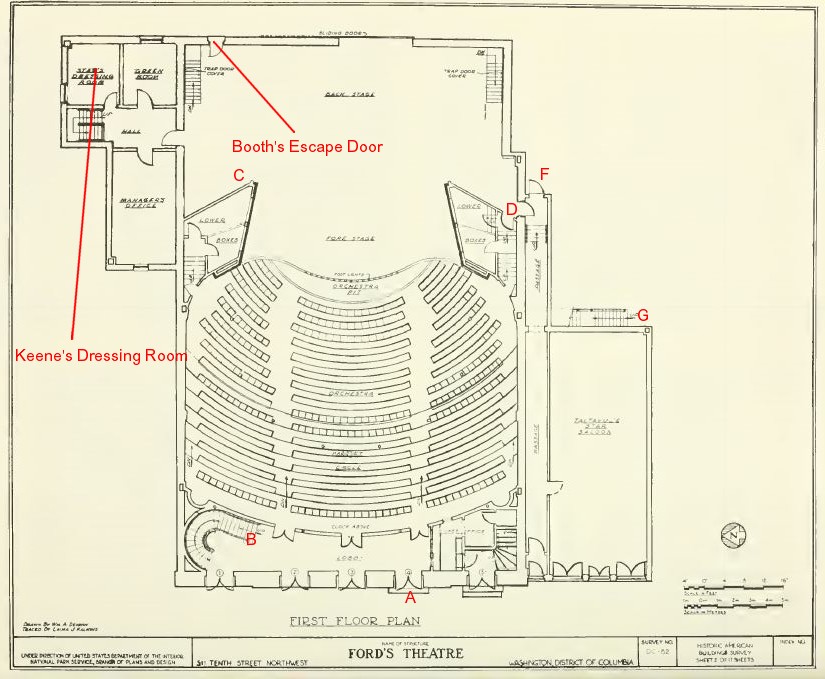
That leaves us with only the tale told by Major Henry Rathbone, which we already know was a hopelessly scripted, rehearsed affair that he told under oath in almost exactly the same words on no less than three occasions. And yet it is the only account we have – the only account we will ever have – so we must look at it in its entirety, as originally told at his April 17, 1865 deposition. It is a strange tale, to be sure, and it would seem to indicate that Rathbone spent more time studying the physical characteristics of the room than he did watching the play:
“The box assigned to the President is in the second tier, on the right hand side of the audience and was occupied by the President and Mrs. Lincoln, Miss Harris and this deponent and by no other person. The box is entered by passing from the front of the building in the rear of the dress circle to a small entry or passageway about eight feet in length and four feet in width. This passageway is entered by a door which opens on the inner side. This door is placed as to make an acute angle between it and the wall behind it on the inner side. At the inner end of this passageway is another door standing squarely across and opening into the box. On the left hand side of the passageway and very near the inner end is a third door which also opens into the box. This latter door was closed. The party entered the box through the door at the end of the passageway. The box is so constructed that it may be divided into two by a movable partition, one of the doors described opening into each. The front of the box is about ten or twelve feet in length and in the center of the railing is a small pillar overhung with a curtain. The depth of the box from front to rear is about nine feet. The elevation of the box above the stage including the railing is about ten or twelve feet.
“When the party entered the box a cushioned armchair was standing at the end of the box furthest from the stage and nearest the audience. This was also the nearest point to the door from which the box is entered. The President seated himself in this chair and, except that he once left the chair for the purpose of putting on his overcoat, remained so seated until he was shot. Mrs. Lincoln was seated in a chair between the President and the pillar in the centre, above described. At the opposite end of the box – that nearest the stage – were two chairs. In one of these, standing in the corner, Miss Harris was seated. At her left hand and along the wall running from that end of the box to the rear stood a small sofa. At the end of this sofa next to Miss Harris this deponent was seated, and the President, as they were sitting, was about seven or eight feet and the distance between this deponent and the door was about the same. The distance between the President as he sat and the door was about four or five feet. The door, according to the recollections of this deponent, was not closed during the evening.
“When the second scene of the third act was being performed and while this deponent was intently viewing the proceedings upon the stage with his back toward the door he heard the discharge of a pistol behind him and looking round saw through the smoke, a man between the door and the President. At the same time deponent heard him shout some word which deponent thinks was ‘Freedom.’ This deponent instantly sprang towards him and seized him. He wrested himself from the grasp and made a violent thrust at the breast of this deponent with a large knife. Deponent parried the blow by striking it up and received a wound several inches deep in his left arm between the elbow and the shoulder. The orifice of the wound is about an inch and a half in length and extends upwards towards the shoulder several inches. The man rushed to the front of the box and deponent endeavored to seize him again but only caught his clothes as he was leaping over the railing of the box. The clothes, as this deponent believes, were torn in this attempt to seize him. As he went over upon the stage, deponent cried out with a loud voice ‘Stop that man.’ Deponent then turned to the President. His position was not changed. His head was slightly bent forward and his eyes were closed. Deponent saw that he was unconscious and, supposing him mortally wounded, rushed to the door for the purpose of calling medical aid. On reaching the outer door of the passageway as above described, deponent found it barred by a heavy piece of plank, one end of which secured in the wall and the other resting against the door. It had been so securely fastened that it required considerable force to remove it. This wedge or bar was about four feet from the floor. Persons upon the outside were beating against the door for the purpose of entering. Deponent removed the bar and the door was opened. Several persons who represented themselves to be surgeons were allowed to enter. Deponent saw there Colonel Crawford and requested him to prevent other persons from entering the box. Deponent then returned to the box and found the surgeon examining the Presidents person. They had not yet discovered the wound. As soon as it was discovered, it was determined to remove him from the Theatre. He was carried out this deponent then proceeded to assist Mrs. Lincoln, who was intensely excited, to leave the Theatre. On reaching the head of the stairs, deponent requested Major Potter to aid him in assisting Mrs. Lincoln across the street to the house which the President was being conveyed. The wound which the deponent had received had been bleeding very profusely and on reaching the house, feeling very faint from the loss of blood, he seated himself in the hall and soon after fainted away and was laid upon the floor. Upon the return of consciousness deponent was taken in the carriage to his residence.
“In review of this transaction it is the confident belief of this deponent that the time which elapsed between the discharge of the pistol and the time when the assassin leaped from the box did not exceed thirty seconds. Neither Mrs. Lincoln nor Miss Harris had left their seats.”
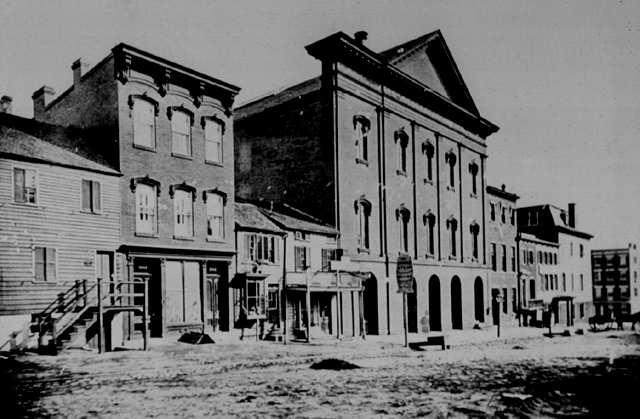
Rathbone’s deposition and subsequent testimony were given at a time when attorneys did not have the luxury of submitting photographic evidence to set the scene for jurors. It appears then that prosecutors used his detailed physical description to paint a mental image for those in the courtroom. And it is very hard to believe that Rathbone would have spontaneously offered up such testimony. Those details were undoubtedly provided to him as part of the script he appears to have been following.
Let us now look at all the other reasons why Rathbone’s account is seriously lacking in credibility. First of all, he claims that the alleged assailant was in the box for up to thirty seconds after shooting Lincoln, long enough to grapple with and seriously wound Rathbone. But the accounts of other witnesses in the theater that evening directly contradict that notion. A witness identified only as “Basset,” for instance, claimed that “A second after the shot was fired a man vaulted over the ballister of the box.” Witness Frederick Sawyer wrote that, “The whole occurrence, the shot, the leap, the escape – was done while you could count to eight.” Actor Harry Hawk, after describing the sequence of events, claimed that “The above all occurred in the space of a few seconds, and at the time I did not know the president was shot.”
How then was there time for the alleged struggle with Rathbone? And if Rathbone had been grappling with an assailant as said assailant was leaping over the front railing, as Rathbone claimed, those actions would have been visible to many of the witnesses in the theater. And yet none of the witnesses who claimed to see the man leap from the box mentioned seeing him struggling with Rathbone either before or while doing so.
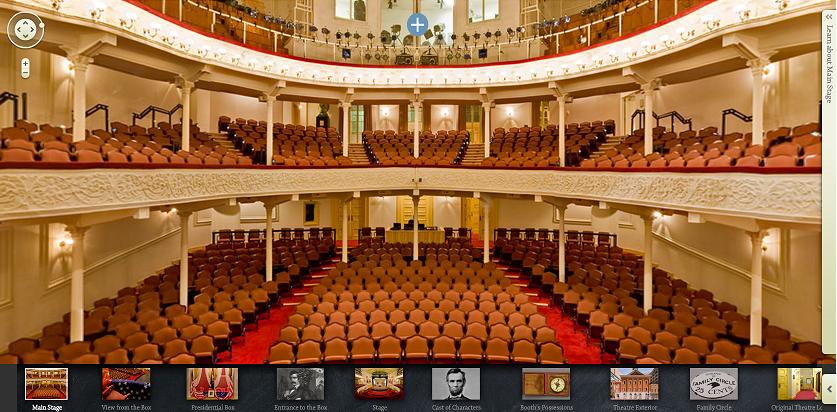
Another problem is that Rathbone claims to have suffered a substantial wound that bled profusely, so much so that his fiancé allegedly found herself drenched in blood, and yet of all the witnesses who said they saw the fleeing man prominently brandish a large knife as he made his exit across the stage, not one of them mentioned seeing any blood on that knife. Or on the man’s hands. Or on his clothing. How is it possible that he could have cut Rathbone so severely, and then continued grappling with him, and yet walked away with no visible blood on him?
Yet another minor problem is that neither Rathbone nor his fiancé made any mention of his very serious wound ever being treated. He claimed that the wound was so severe that he passed out from blood loss, but that he then was merely taken home and dropped off. According to the official story, there were at least three skilled surgeons on hand, none of whom could really do much for the mortally wounded Lincoln. Why then didn’t anyone bother to attend to such a grave wound inflicted on a guest of the President? From what I hear, those severed arteries can be a real killer if left unattended.
What we seem to have here is a situation in which: (a) witness accounts don’t allow for enough time for Rathbone to have been seriously wounded; (b) Rathbone never received treatment for a serious wound; (c) the knife that allegedly inflicted the wound was bloodless just seconds later, as was the guy carrying it; and (d) none of the self-proclaimed witnesses in the theater that night saw Rathbone grappling with his alleged assailant.

Moving on to other peculiarities in Rathbone’s account, one obvious question that is raised is: why would John Wilkes Booth, or anyone else entering the box for the purpose of killing Lincoln in the manner in which it occurred, take the time to wedge the outer door shut? Any pursuers weren’t going to come from that direction. And if the alleged plan went awry, the assailant might need to flee in that direction. So why cut off a possible means of escape? And how is it that a sturdy wood plank of the precise length needed to do the job just happened to be on hand? Those are questions that historians have never really provided satisfactory answers to.
According to Rathbone’s account, the inner door to the box was open all night. How then would the party not have heard an intruder enter the outer door and then close it and forcibly wedge it shut … before sneaking up behind the President? It doesn’t seem possible for an uninvited intruder to have done that. And there was no reason to do it. Booth, it will be recalled, was ludicrously armed with a single-shot derringer. The plan, therefore, was heavily dependent upon the element of surprise. Why then risk discovery by pointlessly wedging the door shut?
Who then really wedged that door shut and why? Did it benefit the alleged assailant, or did it provide a window of opportunity to stage the scene before any responders could get to the president?
Several other questions are raised by Rathbone’s account, including why the president was seated furthest from the stage and closest to the door? Wouldn’t the guest of honor customarily get the best seat in the house? Why had the furniture in the box that day been arranged to place him furthest from the stage? And being that he was the fourth member of the party, why didn’t Rathbone sit in the fourth chair along the front of the box? Why did he choose instead to sit alone on a sofa slightly behind the others?
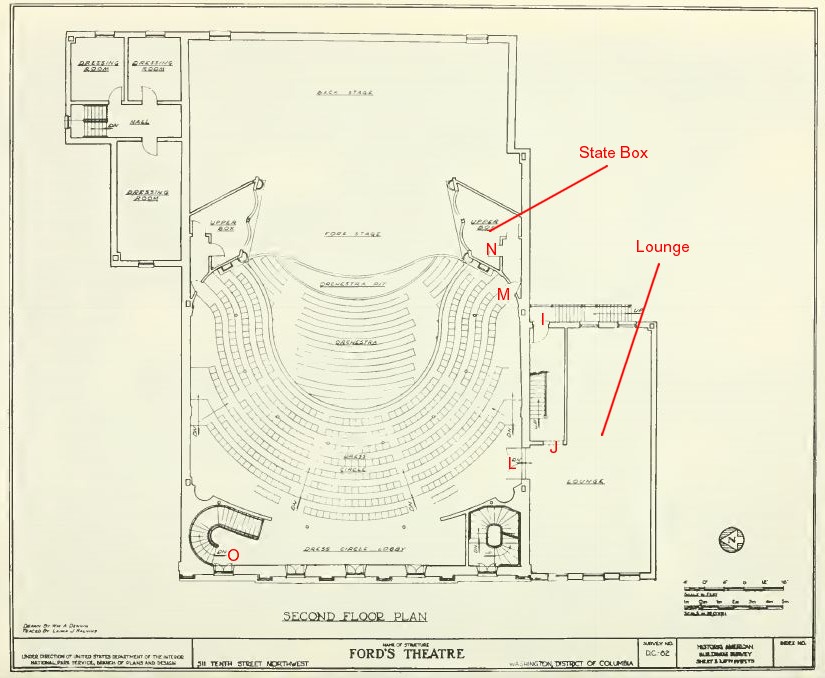
Beyond the problems with Rathbone’s account, there are other problems with the official story of what went down in Ford’s Theatre on April 14, 1865. According to witness accounts, the man fleeing across the stage brandished his knife in his right hand, indicating that he was right-handed. But the bullet that killed Lincoln, purportedly fired by an assailant standing behind him, entered behind his left ear and traveled diagonally through the brain cavity, ending up behind his right eye. That would be a rather tricky shot to pull off for a right-hander. To the extent that historians have addressed this anomaly, it is generally claimed that Lincoln turned his head just as the shot was fired. But that is purely speculation aimed at bringing the known facts of the case in line with the official story.
According to all the early witness accounts, events played out very quickly and the suspect was across the stage and out of the building before anyone realized what had happened. It was only then, when it was too late to apprehend the suspect, that Mary Lincoln’s anguished cries from the box could be heard, along with Rathbone’s futile exhortations to stop the fleeing suspect. But why did it take so long for Mary Todd and the others to cry out?
Mary Lincoln had had her husband gunned down as he sat right beside her, hand in hand. She had then witnessed a violent struggle between her husband’s killer and Major Rathbone, during which Rathbone was grievously wounded, bathing the box in blood. Had Rathbone succumbed to his alleged wound, Mary and Clara would have been left alone in that box with a knife-wielding madman. You would think then that they would have been screaming bloody murder throughout the ordeal, and quite likely trying to exit that box. Help, after all, was just steps away.
But instead the two ladies remained stoic, and seated, throughout the performance. It wasn’t until the assailant had leaped from the box to the stage, regained his footing, run across the stage and then exited the building that Mary verbally responded to the attack. And Clara Harris never responded at all.
Why the curiously delayed reactions from everyone in the presidential box? And why, as previously asked in this series, would the assailant have chosen such a fundamentally preposterous weapon as a single-shot derringer for this mission? And who would plan an escape route that included an exceedingly risky leap onto a very hard stage floor below, especially while wearing riding boots with spurs? Was that really a planned escape route, or was it an improvised one?
Such are the questions that historians have avoided asking for 150 years now.
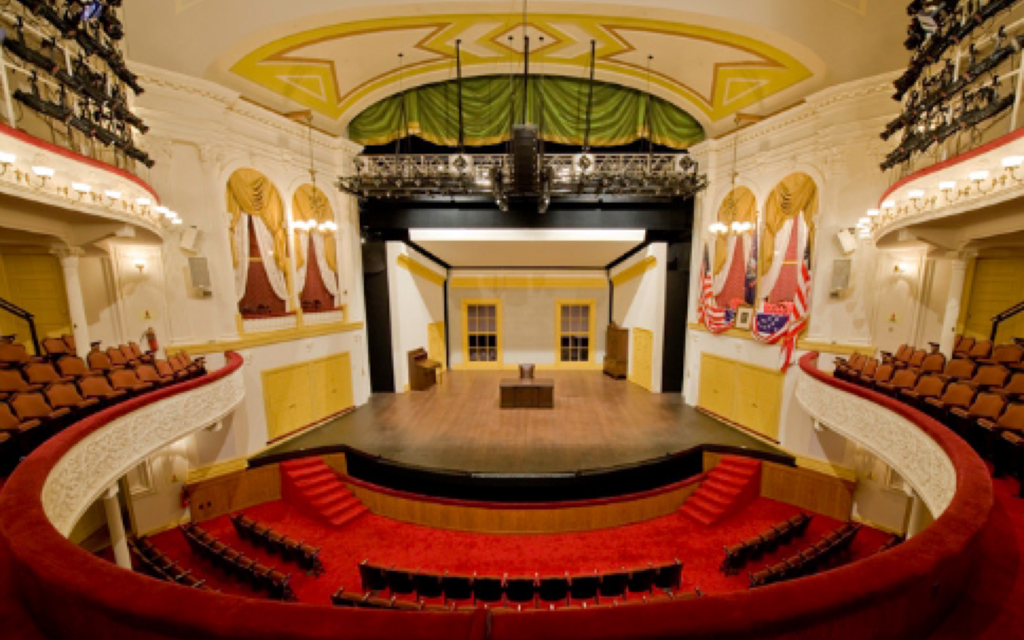
One thing that we cannot definitively conclude from the early witness accounts, contrary to popular opinion, is that the guy who hastily exited Ford’s Theatre that evening was John Wilkes Booth. In witness accounts recorded years after the official story had cast a long shadow over that day’s events, Booth’s name pops up fairly often. But it isn’t so easy to find in the early accounts.
One guy closest to the scene was Army Captain Theodore McGowan, who was seated in Ford’s Theatre not far from the entrance to the president’s box. I like to think that this guy was an upright sort of guy, primarily because he had a very honorable name. When called upon to testify at the military tribunal, McGowan had this to say: “I was present at Ford’s Theatre on the night of the assassination. I was sitting in the aisle leading by the wall toward the door of the President’s box, when a man came and disturbed me in my seat, causing me to push my chair forward to permit him to pass; he stopped about three feet from where I was sitting, and leisurely took a survey of the house. I looked at him because he happened to be in my line of sight … I know J. Wilkes Booth, but, not seeing the face of the assassin fully, I did not at the time recognize him as Booth.”
So here we have a guy who knew Booth, and yet from just three feet away, with the guy directly in his line of sight, he did not recognize the man in the theater as Booth. It is a fairly safe bet that the government exerted considerable pressure on Captain McGowan to positively identify Booth, and yet he proved unable, or unwilling, to do so. Curious also that McGowan referred to him in the present tense when Booth was supposed to be dead.
So what are we to make of all of this? Was Rathbone really gravely injured? Or was his wound a substantially less severe one that was self-inflicted while responders were held at bay by the barricaded door? Was it really John Wilkes Booth who entered the presidential box that evening? And whoever it was, did he enter for the purpose of assassinating the president? Would a small derringer have been the weapon of choice for an assassin, or was it a weapon that would have been easy for someone else in that box to have brought along?
One thing we do know – Henry Rathbone’s actions in the years after the assassination clearly demonstrated that he was fully capable of two things: murder, and self-inflicted knife wounds.

This is absolute silliness. Booth blocked the door because he had a plan which involved waiting for a particular line in the play to cause a roaring laughter to mask the shot report. He didn’t want anyone to walk in behind him as he waited for his moment. Booth having all day to plan could easily come up with this board, your ridiculous theory requires rathbone to just luckily find the board there! And this is only one example of many errors and incorrect assumptions in your theory. Rathbone didn’t kill Lincoln.
Thank you, Nathan. I agree with you. I have been in Ford’s Theater back in the 50’s and early 60’s before the renovations. I agree that there are “many errors and incorrect assumptions in (this) theory.” I have lived in Southern Maryland and have studied this subject for years. Southern Maryland was CONFEDERATE.
Much of Maryland was not Union. But Lincoln did not want Maryland to secede from the Union since it was next to the Nation’s Capitol.
I have not read the rest of this report, but David Herold and Booth both had associations with Dr. Mudd. They met him before the assassination in Southern Maryland. They scouted the area. The original plan was to kidnap Lincoln and transport him to Richmond for ransom. But the Civil War ended before that could happen. They tried to waylay Lincoln’s carriage when it was on the way to the Soldiers Home in DC but could not manage to succeed in that attempt.
There are many more Confederate players in this piece of history but I will wait until I finish the articles before I mention them.
Does Thomas Jones enter this story? He was a Confederate for sure. He had owned slaves.
I’m not finished yet with the articles, so…
It sounds as though you haven’t actually read the entire article. There were two doors. The door which would have been problematic would be the inside door through which help would arrive. Furthermore, what a silly plan Booth so thoughtfully planned out: he bothers to lug a board along with him but it doesn’t enter his mind to bring a revolver or extra gun for reassurance? Just the one shot? As for Rathbone having to bring the board – it would be much easier being an inside party to arrange for the door to be barred ahead of time. Or, perhaps the outside door was already barred from the start. If the door were barred from the start – which makes sense – then, of course, Booth couldn’t have entered. So the story required that Booth himself barred the door upon entering.
The official version is by far sillier than what Mr. Mcgowan has here proposed.